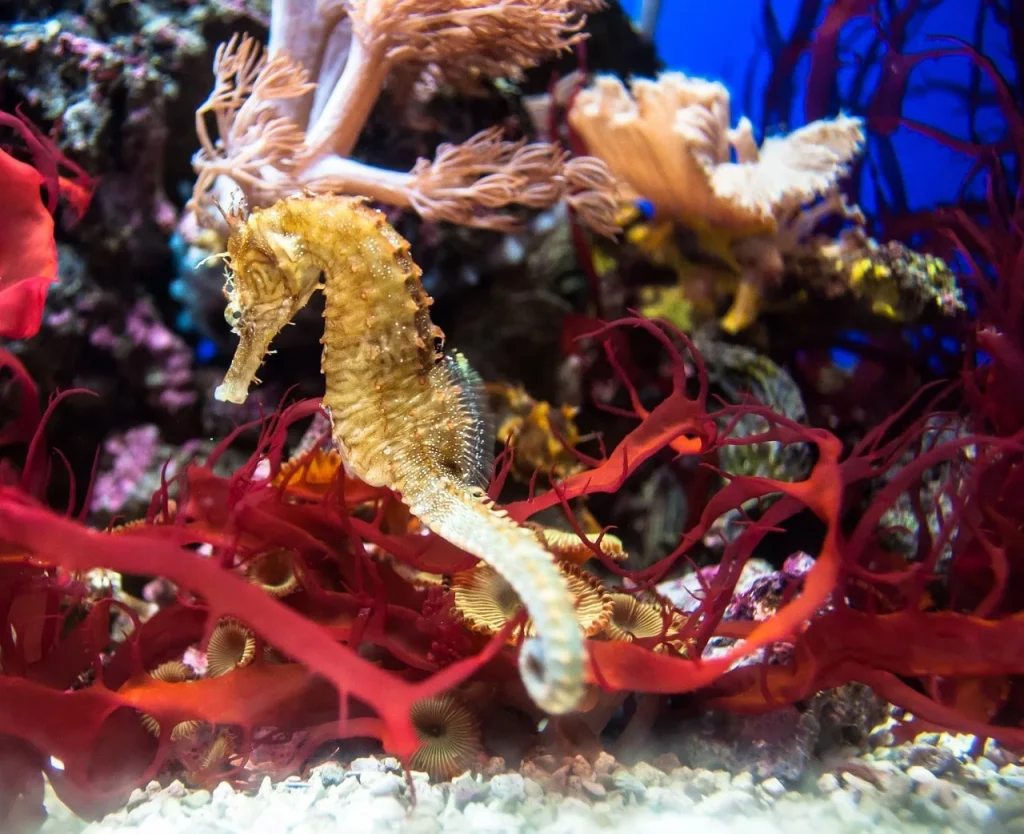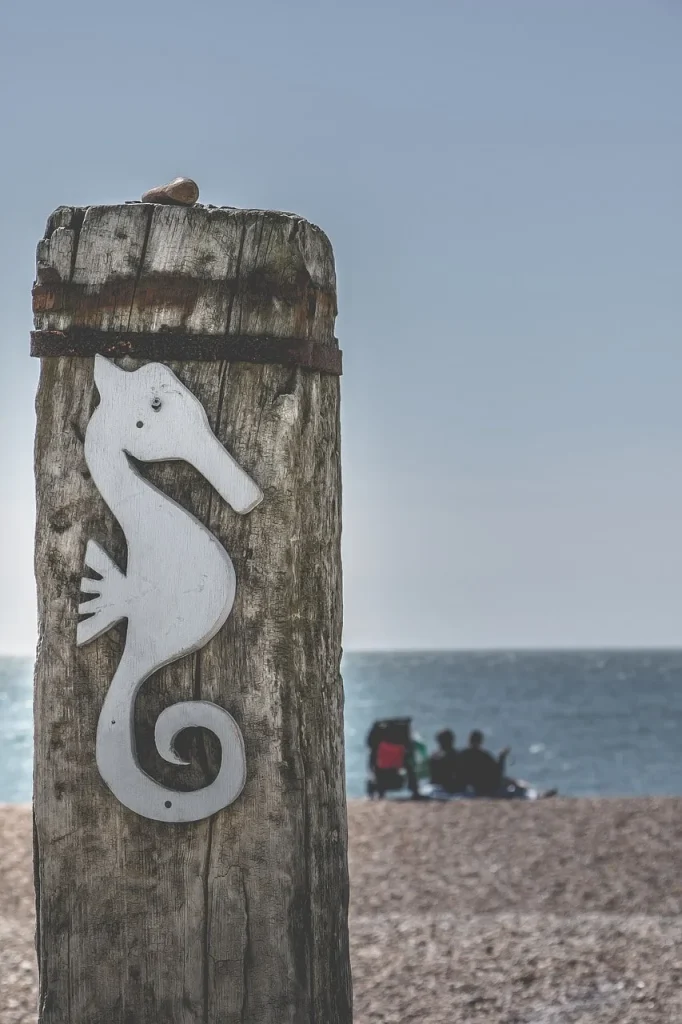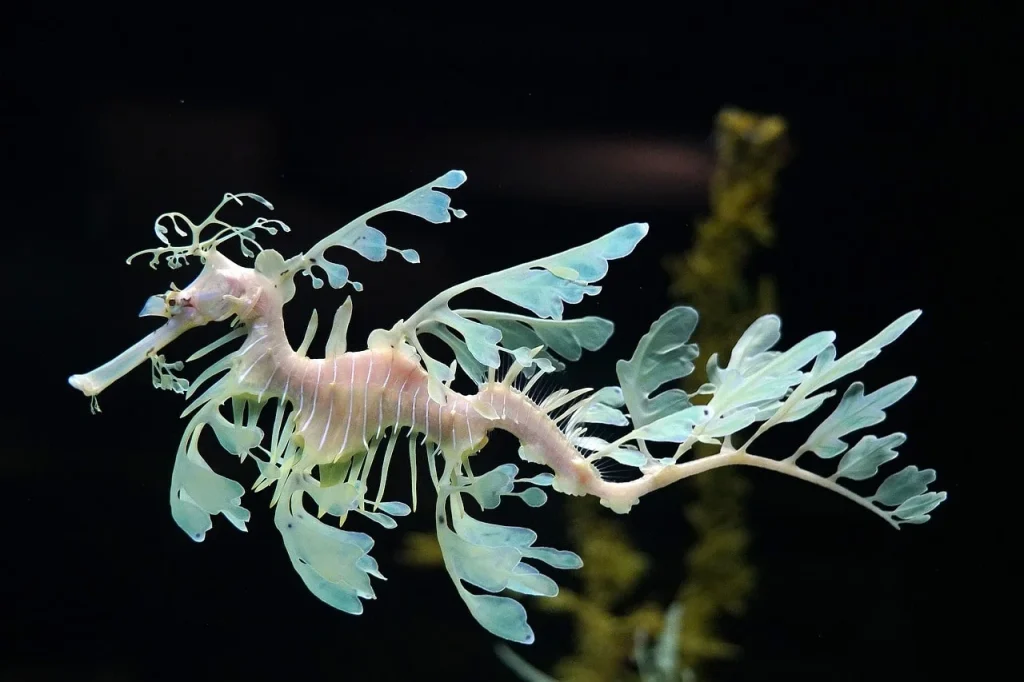Let’s talk about seahorses, the ocean’s equivalent of a pocket-sized unicorn. With their distinct heads and curled tails, they look like they could belong in a mystical underwater kingdom.
But don’t be fooled by their delicate appearance; these creatures are as tough as they come. Did you know that seahorses can move each eye independently? Imagine trying to do that for your next party trick!
Beyond their quirky looks and party tricks, they have a lot to teach us about life under the sea. Ever wondered what secrets they’re keeping from us down there? Let’s find out.
The sea, once it casts its spell, holds one in its net of wonder forever.
Jacques Cousteau
Seahorse Facts
Before we dive into their fascinating world, remember to keep your eyes peeled for details: I created a quiz at the end of this article to test your expertise on these unique creatures. Read carefully to prove you’re a seahorse savant!
- Unlike most other fish, they have a unique ability to hover in water thanks to their small, finned appendages.
- Their eyes can move independently, allowing them to look forward and backward at the same time.
- These creatures are monogamous during the breeding season, often pairing with the same mate.
- Their skin, rather than scales, covers their bodies, providing better camouflage among sea vegetation.
- A male carries the eggs in a pouch until they hatch, a rare trait in the animal kingdom.
- Some species can change color to blend seamlessly with their surroundings, making them masters of disguise.
- They have prehensile tails, allowing them to grip onto eelgrass and coral to prevent being swept away by currents.
- Despite their serene appearance, they are ambush predators, snapping up prey by quickly sucking it into their mouths.
- Their bodies are encased in a series of bony plates, providing protection against predators.
- These fascinating creatures lack a stomach, meaning they must eat almost constantly to stay alive.
- Capable of rapid growth, some species can increase their body weight by 50 times in their first few weeks of life.
- They communicate through subtle changes in color and body movements, a complex language still not fully understood.
- The smallest species measures just over an inch in length, while the largest can grow up to a foot long.

- Populations are in decline due to habitat destruction, pollution, and the traditional medicine trade.
- They swim in an upright position, a trait that is rare among fish and contributes to their mythical appearance.
- Curiously, they are not strong swimmers and can die of exhaustion in turbulent water.
- These animals pair up to perform morning dances together, which strengthens their bond and synchronizes their reproductive cycles.
- In the wild, their lifespan is typically 1 to 5 years, though this can vary significantly by species.
- Due to their unique mode of reproduction, they are often studied in evolutionary biology and gender role research.
- Despite their popularity in aquariums, they have specific care requirements that make them challenging to keep in captivity.
- They can consume 3,000 or more brine shrimp per day, showcasing their voracious appetite despite their tranquil demeanor.
- Their habitat ranges from tropical to temperate waters, showing a surprising adaptability to different environmental conditions.
- Research indicates that water pollution affects their reproduction, leading to fewer offspring and lower survival rates.
- With a head and neck resembling a horse, their name is derived from ancient Greek, meaning ‘horse’ and ‘sea monster’.
- They are considered a flagship species for marine conservation efforts, highlighting the need for healthy seagrass and coral reef ecosystems.
- Genetic studies have revealed a remarkable resilience to changes in their environment, with some species adapting quickly to warmer waters.
- Interestingly, their slow movements and camouflage make them nearly invisible to both predators and prey.
- Fossil records suggest that they have existed for about 3 million years, adapting to various changes in the marine environment.

- Conservation efforts for them include breeding programs in captivity to reintroduce them into the wild and protect their natural habitats.
- Their tail’s gripping strength is being studied for biomedical applications, inspiring new technologies in robotics and medical devices.
- They are part of the Syngnathidae family, which also includes pipefish and leafy sea dragons, known for their elongated bodies.
- Some species engage in nocturnal activities, showing a different side of their behavior under the cover of darkness.
- Due to their unique feeding mechanism, they lack teeth and a stomach, relying on a rapid suction method to ingest food.
- Environmental changes, such as rising sea temperatures and acidification, pose significant threats to their survival.
- Their courtship displays are complex and involve intricate dances, often lasting for hours, to charm their prospective partners.
- Aquarium breeding programs have successfully bred several species, helping to reduce the demand from wild populations.
- They have a low reproductive rate, which, combined with high demand for traditional medicines, puts pressure on their populations.
- Interesting research has been done on their genetic makeup, revealing insights into their evolutionary history and resilience.

- Certain cultures hold them in high esteem, believing them to bring good luck and ward off evil spirits.
- Their ability to stay motionless makes them formidable predators, surprising prey that swims too close.
- Advanced camouflage allows them to mimic the appearance of algae-covered rocks, avoiding detection by predators.
- Marine protected areas (MPAs) play a crucial role in conserving their habitats and supporting biodiversity and ecosystem health.
- Through their lives, they might encounter over 1,000 potential mates, yet form a bond with only one for the season.
- Their ability to absorb dissolved oxygen through their skin is especially vital since they do not possess gills like most fish.
- A fascinating genetic adaptation allows them to adjust their body temperature to match their surroundings, minimizing detection by predators.
- Unlike most fish that lay thousands of eggs, they produce a relatively small number of offspring, each receiving a greater investment of parental care.
- They exhibit a remarkable paternal care system, with the male incubating the eggs until they hatch, a rarity in the animal kingdom.
- Their slender bodies are ill-suited for fast swimming, relying on stealth and cunning rather than speed to evade predators and capture prey.
- Researchers have discovered that they use stereopsis, or depth perception, to judge the distance of their prey, a sophisticated visual ability shared with humans.
- Finally, despite their fragile appearance, they are survivors, adapting to the changing marine world with uncanny resilience.
Seahorse Myths

Diving deeper into the world of seahorses, it’s time to sort fact from fiction. In the next section, we’ll unravel some of the most common myths surrounding these unique creatures.
- Only Female Seahorses Give Birth
The myth here is flipped; it’s actually the male ones that are equipped with a unique brood pouch where they carry and birth the young. This fascinating reversal of typical birthing roles in the animal kingdom highlights the seahorse’s unique place in marine life. - Seahorses Are Monogamous For Life
While it’s commonly believed that they pair for life, the reality is more complex. Some species of seahorses are loyal to one partner during a breeding season, but many will change partners. This adaptability is thought to increase genetic diversity and survival chances of their offspring. - Seahorses Can’t Swim Well
Often labeled as poor swimmers due to their unusual body shape and small fin size, they are actually quite adept at maneuvering in their environment. Their ability to hover and move smoothly is facilitated by the rapid fluttering of their dorsal fin, which allows them to navigate with precision. - Seahorses Eat Like Other Fish
Contrary to what might be assumed, they don’t eat like other fish; they lack a stomach. Food passes through their digestive systems so quickly that they need to eat almost constantly to stay alive. This high metabolism demands that they consume up to 3,000 brine shrimp a day. - Seahorses Are Common and Not At Risk
The truth is that many species are under threat due to habitat destruction, pollution, and overfishing for traditional medicine and the aquarium trade. Their populations are declining in many parts of the world, making them the subject of conservation efforts to ensure their survival for future generations.
No products found.
Seahorse FAQ

We continue with the FAQ section. This is the last section before the quiz, so read carefully if you want to score a perfect ten.
- Are seahorses asexual?
No, they are not asexual. They are very sexual beings, forming monogamous pairs and engaging in elaborate courtship dances before mating. The unique part? It’s the males that carry the pregnancy! - Can seahorses live in freshwater?
They are strictly saltwater creatures, thriving in marine environments ranging from shallow tropical reefs to deeper, temperate waters. Unfortunately, they cannot survive in freshwater habitats. - Are seahorses mammals?
Despite their unique appearance and behaviors, they are not mammals. They are fish, complete with gills for breathing underwater and fins for navigating their aquatic homes. - How do seahorses give birth?
Seahorse dads take on the incredible role of pregnancy. After the female deposits her eggs into his specialized pouch, he fertilizes them internally. He then carries the eggs until they hatch, eventually experiencing contractions to release the fully formed, tiny seahorses into the water. - Can seahorses change gender?
They do not change gender. Each seahorse is born either male or female and remains that way for life. Their reproductive roles are fixed, with males carrying the eggs and females producing them.
Seahorse Trivia

Welcome to seahorse trivia, where getting a question wrong might just turn your bathtub into a seahorse sanctuary overnight. Dive in, but beware, the stakes are as high as the sea is deep!
Seahorse Merch
If you are a true seahorse fan, then you definitely need to check out our merchandise. You can find T-shirts, hoodies, mugs, and tote bags for your favorite designs. Feel free to check out all the other designs in our shop.
Conclusion
Seahorses are truly the magicians of the sea, with their ability to change color and blend into their surroundings.
These tiny creatures carry big secrets about the ocean’s wonders. Seahorses are not just interesting to look at, but they also play an important role in the ocean by eating tiny creatures that are harmful to the environment.
Protecting seahorses means protecting the ocean. So, next time you see one, remember, you’re looking at a real-life superhero of the sea. Till next time, stay curious and explore more. Cheers.
1 Source Used For This Article

